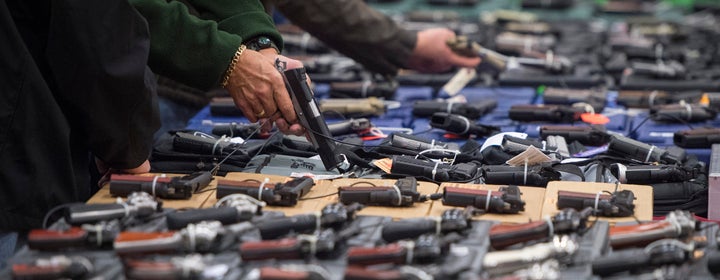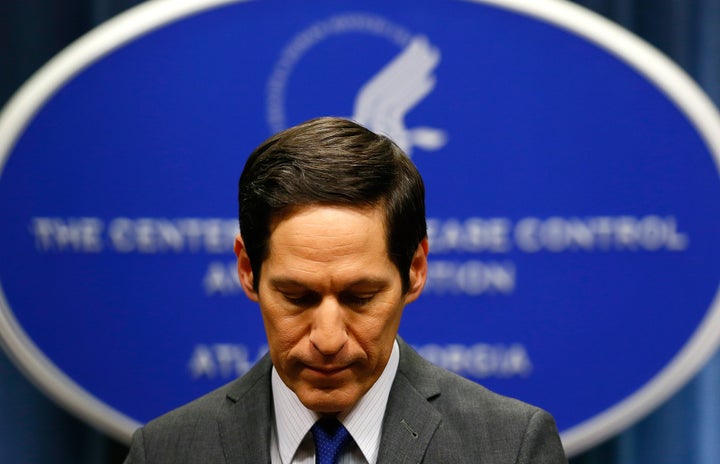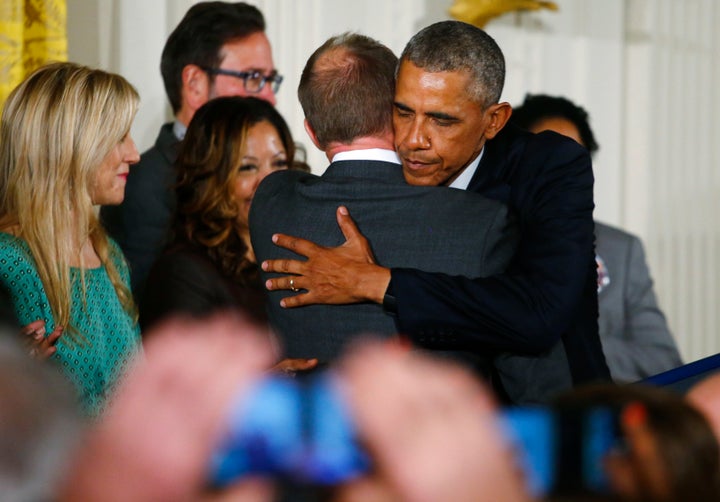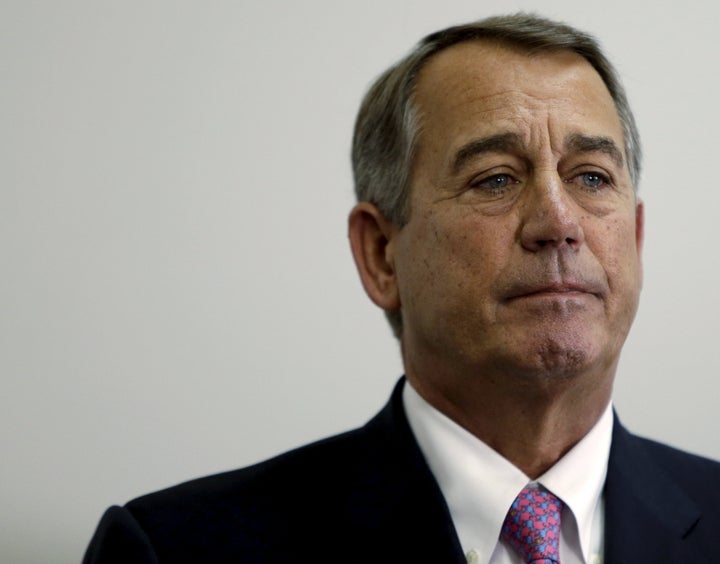
WASHINGTON -- Looking back, nearly 20 years later, Jay Dickey is apologetic.
He is gone from Congress, giving him space to reflect on his namesake amendment that, to this day, continues to define the rigid politics of gun policy. When he helped pass a restriction of federal funding for gun violence research in 1996, the goal wasn't to be so suffocating, he insisted. But the measure was just that, dampening federal research for years and discouraging researchers from entering the field.
Now, as mass shootings pile up, including last week's killing of nine at a community college in Oregon, Dickey admitted to carrying a sense of responsibility for progress not made.
"I wish we had started the proper research and kept it going all this time," Dickey, an Arkansas Republican, told the Huffington Post in an interview. "I have regrets."
The politics of gun control were as divisive in the 1990s as they are today. Republicans had won big in the '94 elections by campaigning against President Bill Clinton's gun control legislation. And in the spring of 1996, the National Rifle Association and its allies set their sights on the Centers for Disease Control and Prevention for funding increasingly assertive studies on firearms ownership and the effects on public health. The gun rights advocates claimed the research veered toward advocacy and covered such logical ground as to be effectively useless.
At first, the House tried to close down the CDC's entire, $46 million National Center for Injury Prevention. When that failed, Dickey stepped in with an alternative: strip $2.6 million that the agency had spent on gun studies that year. The money would eventually be re-appropriated for studies unrelated to guns. But the far more damaging inclusion was language that stated, “None of the funds made available for injury prevention and control at the Centers for Disease Control and Prevention may be used to advocate or promote gun control.”
Dickey proclaimed victory -- an end, he said at the time, to the CDC's attempts "to raise emotional sympathy" around gun violence. But the agency spent the subsequent years petrified of doing any research on gun violence, making the costs of the amendment cleareeven to Dickey himself.
He said the law was over-interpreted. Now, he looks at simple advances in highway safety -- safety barriers, for example -- and wonders what could have been done for guns.
"If we had somehow gotten the research going, we could have somehow found a solution to the gun violence without there being any restrictions on the Second Amendment," Dickey said. "We could have used that all these years to develop the equivalent of that little small fence."

Among the proposals that gun control advocates push in the wake of high-profile instances of gun violence, reopening federal funding for research would appear to be the least objectionable. It doesn't target a specific firearm, restrict ammunition, or enhance oversight of gun sales. It simply allows taxpayer money for scientific studies. Indeed, since the Oregon shooting, such ideological opposites as Hillary Clinton and Ben Carson have respectively said they would and could support it.
But gun rights groups have long warned that a research funding reversal would be a gateway to government advocacy of gun control and, generally, a waste of money, since there is non-government research available. In 2011, congressional Republicans further restricted funding by applying the Dickey amendment to the National Institutes of Health. And in the aftermath of the Charleston, South Carolina, church massacre in the spring, they quietly upheld the CDC language on the grounds that "a gun is not a disease."
“The CDC is there to look at diseases that need to be dealt with to protect public health,” declared House Speaker John Boehner (R-Ohio).
The collateral damage of this stalemate has been felt both at the university level and, a step removed, in the statehouses where gun policy is made.
"If there is no research, it is harder to make suggestions for policy reform," said Dr. Garen Wintemute, director of the Violence Prevention Research Program at the University of California, Davis. "And if you have a vested interest in stopping policy reform, what better way to do it than to choke off the research? It was brilliant and it worked. And my question is how many people died as a result?”
Wintemute actually counts himself fortunate among gun violence researchers. He was overseeing several CDC-funded projects when the Dickey amendment passed in '96. The law brought an end to his CDC grants. He scrambled for private funding and eventually completed his study on predictors of criminal behavior among people who purchase firearms legally. Years later, he received funding from the National Institute of Justice -- which was unaffected by the amendment -- though he spent his own money on research "just to keep the lights on and employed," he said.
In recent years, the climate has grown brighter. After the 2012 shooting deaths of 20 first grade students and six staff members at a school in Newtown, Connecticut, President Barack Obama instructed federal agencies to interpret the Dickey amendment literally -- as a restriction on funds for advocacy, not on funds for research.

The CDC has hesitated in acting on that directive, both because of its limited resources and, gun control advocates suspect, a fear of political backlash. Indeed, The New York Times reported that as a courtesy, the center flags for the NRA any study that has anything to do with firearms.
The NIH, however, appears to be less intimidated. Wintemute received a two-year grant from the National Institute on Alcohol Abuse and Alcoholism in 2013, worth $700,000, to study alcohol abuse as a risk factor among people who legally purchase firearms. He now is conducting a 100,000-person study in California.
"Compared to five years ago, the funding picture for a few of us who have done this work for a long time is rosy," Wintemute said. "Compared to what it requires, it is still bleak. We have lost 20 years of concentrated effort."
Others have found the field fairly difficult to traverse. Dr. Douglas Wiebe, an associate professor of epidemiology at the Perelman School of Medicine at the University of Pennsylvania, worked on a 2009 study on the link between gun possession and gun assault that is believed to have sparked Congress' interest in applying the Dickey amendment to the NIH. He called the restriction of funds "not fatal" to his field, "but very close to it." Investigators, he explained, are being forced toward less-politically contentious studies, which makes it close to impossible to conduct sound epidemiological research.
"That’s a real problem because it is violent death that really needs more research in the field," Wiebe explained. "Lives are being lost."
Dr. Stephen Hargarten, a professor and chairman of emergency medicine at the Medical College of Wisconsin, also refocused his financing after the CDC ban, salvaging his research in the process. But the dry funding climate has had a "dampening effect" on young scientists, he said.
"They look at the landscape of funding and ask, 'Would you enter into that field?'" Hargarten said.
The issue, however, isn't just the specific restriction on CDC funding, but a larger movement to remove science from gun policy, according to Akiva Liberman a senior fellow in the Justice Policy Center at the Urban Institute. Under law, for example, the Bureau of Alcohol, Tobacco, Firearms and Explosives is prohibited from keeping a registry of gun transactions and from distributing much of its trace data. These measures not only hamper efforts to combat gun violence, argued Liberman. They make it hard to understand it. The biggest losers are potential victims; the second-biggest are policy makers.
"I think it is hard to figure out what is sensible policy," said Lieberman. "To the extent we don’t build up the ability to research things at more geographically fine levels, we lose the ability to research a lot of the relevant policy options."

Gun groups have been unmoved by these arguments. They cast efforts to retain data or spend taxpayer money on research as poorly disguised, back-door attempts at instituting or facilitating gun control.
The NRA did not return a request for comment for this article. But it has in the past defended the restriction on CDC funding and lobbied for additional bans. During the passage of Obama's Affordable Care Act, for example, the group successfully persuaded Congress to include a provision restricting the ability of doctors to gather data on patients' gun use. Even pro-gun control Democrats didn't stand in the way.
More than anything else, that illustrates how the current system of laws and restrictions came to be. Put simply: The gun lobby has more lawmakers willing to do its bidding than the other side of the debate.
After the Dickey amendment passed in '96, the Knight Ridder media chain did an analysis of the vote. It discovered that three-quarters of those who backed the measure had received a collective $1.6 million from the NRA that calendar year. Only six of the 158 members who opposed the measure had received support from the gun lobby.
Dickey was the NRA's so-called point man on the Hill during his service from 1993 to 2000. He had to leave Congress before changing his stance on CDC funding, which he first did in a 2012 Washington Post op-ed. He urged his former colleagues to evolve before losing the power to legislate.
"I’d tell them there is research and then there is research," Dickey said. "And I would point to this little [highway barricade] fence and say that research has done some good."
